Early Water Quality
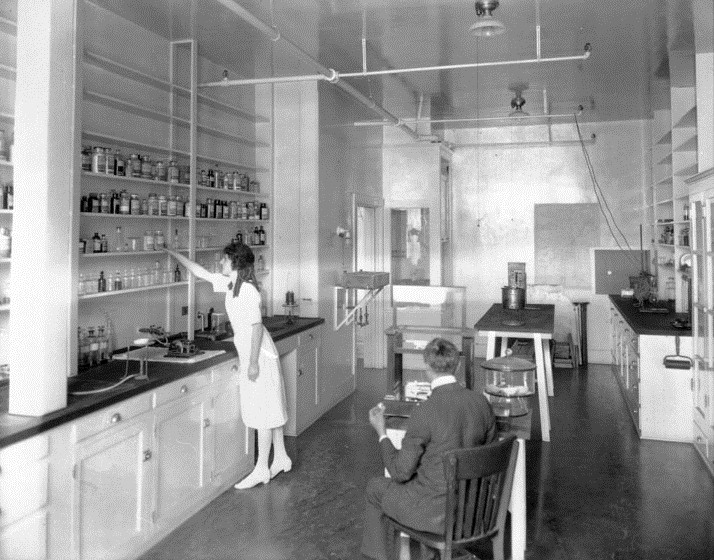 |
|
| (Early 1900s)* - Caption reads: 'Sanitary Engineer's Lab'. |
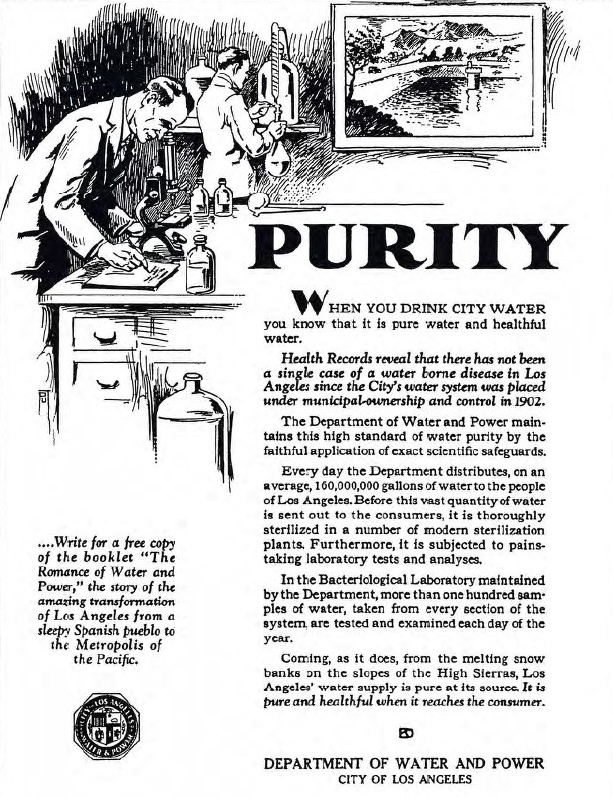 |
|
| (1929)*^ - Municipal Water and Power advertisement published in Los Angeles daily newspapers in 1929. Click HERE to see more. |
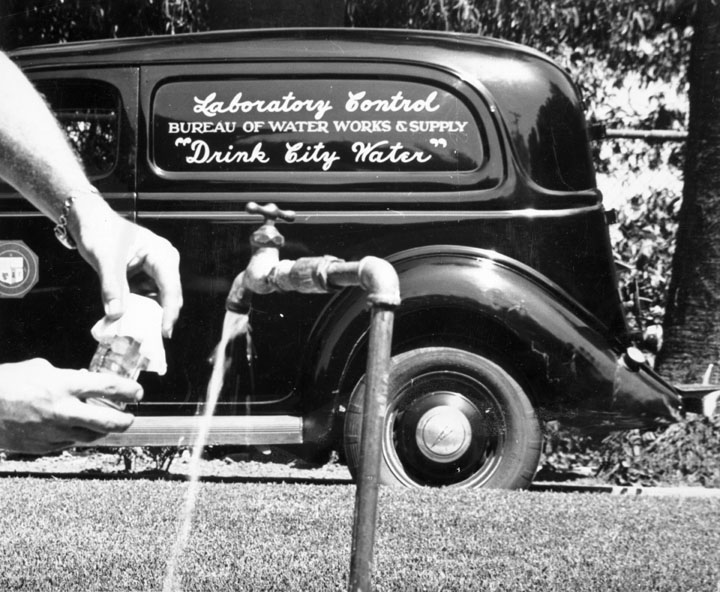 |
|
| (1937)* – “Drink City Water” is the slogan that is being brought to the attention of thousands of Los Angeles citizens daily through the activities of the laboratory control sample trucks operated by the municipal Water Bureau. |
Note: Lettering on truck reads: Bureau of Water Works & Supply. In 1937, Bureau of Water Works & Supply merged with Bureau of Bureau of Power and Light to form Los Angeles Department of Water and Power (DWP).* |
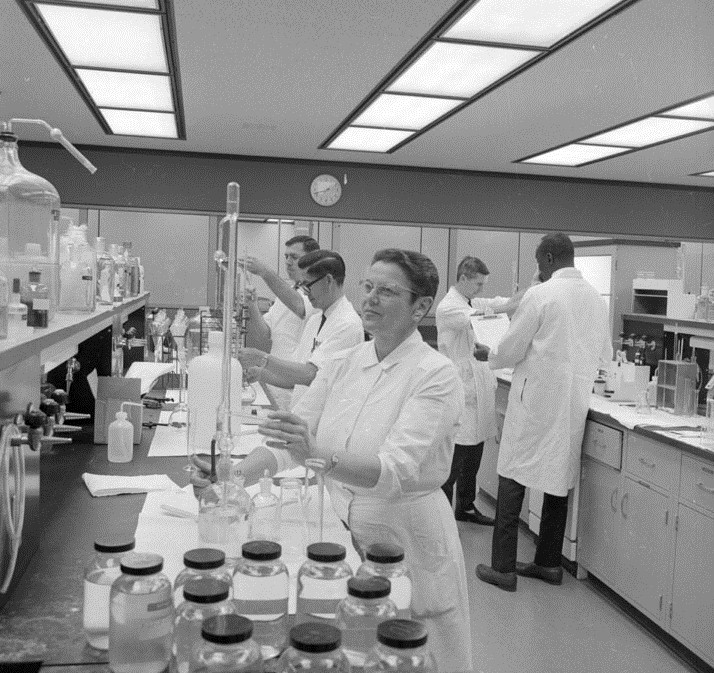 |
|
| (1968)* - Water quality control laboratory at the General Office Building at 111 N. Hope Street. |
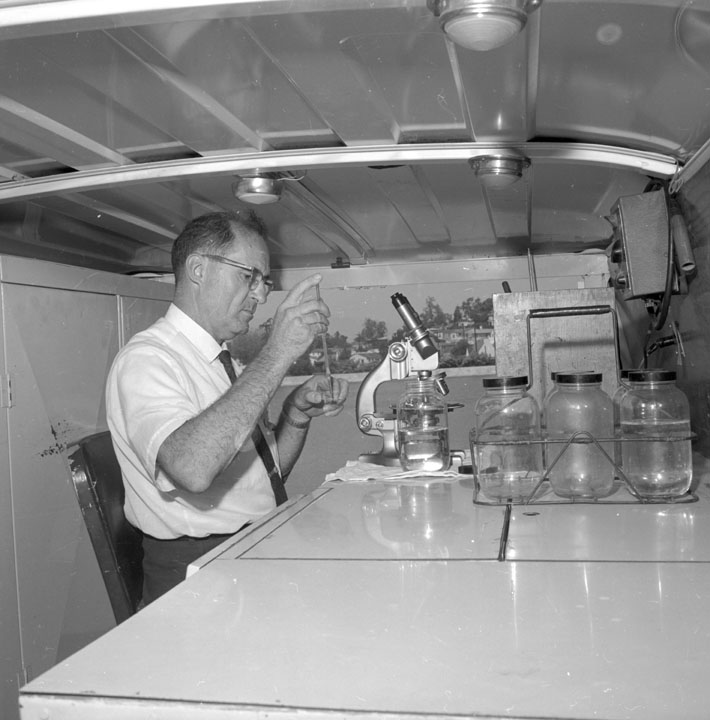 |
|
| (1969)* - Water sampling at Silver Lake. |
LADWP Historic Archive
Water, the average customer thinks nothing more of this common chemical combination than the time it takes to flow from tap to glass.
But to the DWP, maintaining a high standard of water quality is a full-time daily concern, and has been ever since the city purchased the Los Angeles City Water Company in 1902.
“Most of our water is brought from the eastern slope of the Sierra Nevada Mountains from a sparsely populated area. Many procedures are used to protect the water in the Owens Valley and along its 338-mile journey to the city through the Los Angeles Aqueducts,” George Adrian, principal sanitary engineer said.
Some diseases can be carried by water. But since the major source of Los Angeles’ water is virtually isolated form large population centers, few biological impurities are present even before treatment.
Unlike many surface water supplies used in the East, Los Angeles water is not exposed to industrial and chemical pollutants.
Large inland waterways, such as the Mississippi and Ohio Rivers, are affected by industrial pollution. Some New Orleans drinking water, for example, is drawn from the Mississippi River which has hundreds of industrial plants along its banks. But the Los Angeles Aqueduct water supply is practically unaffected by industry, Adrian said.
FOUR WATER SOURCES – Last year (1976), citizens of Los Angeles received water supplied by four converging sources: 77 percent flows from the eastern High Sierras through two separate but parallel Owens River aqueducts; 19 percent was supplied from the underground basin of the Los Angeles River, about one percent came from the Colorado River Aqueduct, and three percent from Northern California via the California Aqueduct. Average daily consumption for fiscal year 1975-76 totaled 548 million gallons.
Working to protect Los Angeles’ water supply, the Sanitary Engineering Division utilizes one of the most modern fully equipped water testing laboratories in the nation to conduct more than 50,000 comprehensive physical, chemical, radiological and biological tests each year.
Conducting these examinations are teams of biologists, concerned with the biological quality of DWP reservoir water; bacteriologists, who test for bacterial content seven days a week; and chemists, who analyze the water’s chemical content. Biological and physical testing is mainly conducted in the field, while chemical and bacteriological testing is done in the lab.
Engineers make weekly visits to each major reservoir to collect a series of samples for water quality monitoring. Over 40 points throughout the distribution systems are also monitored each day. Water sources in the Owens Valley are inspected and sampled weekly.
The surveillance and protection of the water and watershed, backflow protection, water treatment, responses to customer inquiries and operation of the laboratory will cost $3.7 million this year (1977).
EPA QUALITY STANDARDS – As with all U.S. water utilities, the Department is directly affected by the Safe Drinking Water Act passed by Congress in 1974. It directed the Environment Protection Agency (EPA) to set new health-related water quality standards for the nation’s water utilities. These standards that supersede the old 1962 U.S. Public Health Service Drinking Water Standards will become effective in June, 1977.
The new EPA standards set maximum limits on levels of chemicals such as arsenic, barium, cadmium, lead and mercury, but also set reduced limits on turbidity which had previously been considered non-health related. EPA considers turbidity to be health related in that it may interfere with disinfection by chlorination.
“Turbidity (cloudiness), a measure of the fine, suspended particles of clay, silt an vegetable matter in water, is caused by runoff form storms and winds on reservoirs,” Adrian explained.
“While Los Angeles aqueduct water meets all other primary drinking water standards set by the EPA, it does not continuously meet the turbidity requirement of one turbidity unit or less. Recently, turbidity of aqueduct water averaged between three and four turbidity units”.
SOFT VS HARD WATER – Of moderate softness, Owens Valley water has a total mineral content of less than 200 parts per million. Runoff from the eastern slopes of the High Sierras is of high quality due to granitic formations in the area. However, there are some highly mineralized springs, especially in the Hot Creek area near Mammoth Creek that contribute to our Owens River aqueduct supply. The presence of calcium and magnesium, known as hardness, is an important quality criteria in our domestic water supply. The two elements total 25 parts per million in water from this source.
Coupled with DWP efforts to safely bring water to Los Angeles are our endeavors to protect it once it gets here. The introduction of chlorine into the water system assures a water supply safe from bacteria. Electrical and hydraulic devices automatically adjust the amount of chlorine to the desired proportions at points of entry into the distribution system.
“About 15 pounds of chlorine are added per million gallons of water. Drinking a quart of water daily, a person who lives 80 years would consume an amount of chlorine no more than that contained in a tablespoon of salt,” Adrian said.
Indicative of the DWP effort to deliver wholesome water to Los Angeles is the fact that there has not been an outbreak of illness traceable to the city water supply in 72 years.
Drink up with confidence.^
References and Credits
* DWP - LA Public Library Image Archive
*^Municipal Water and Power Advertisements
< Back
Menu
- Home
- Mission
- Museum
- Mulholland Service Award
- Major Efforts
- Board Officers and Directors
- Positions on Owens Valley and the City of Los Angeles Issues
- Legislative Positions on
Water Issues
- Legislative Positions on
Energy Issues
- Recent Newsletters
- Historical Op Ed Pieces
- Membership
- Contact Us
- Search Index